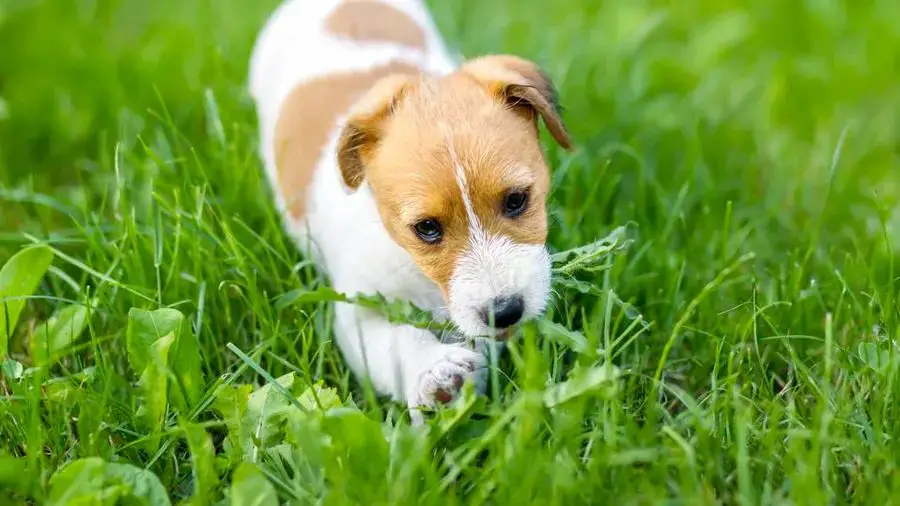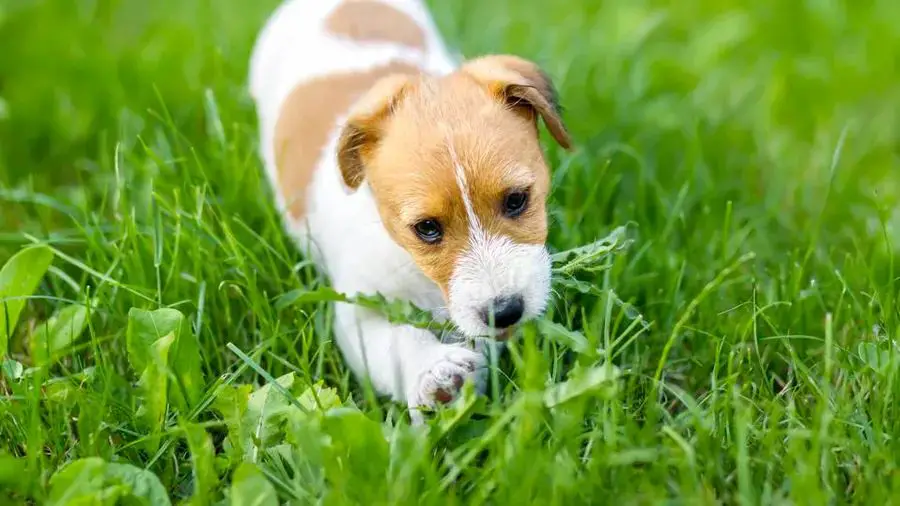Introduction
We’ve all seen it – our dog happily munching away on blades of grass in the backyard or on walks. Eating grass is a normal behavior for many dogs, but under certain circumstances it can lead to a dangerous blockage in their digestive system.
In this article, we’ll explore why dogs eat grass, what types of grass are risky, and how grass can cause a life-threatening blockage in your dog’s stomach or intestines. We’ll cover the symptoms to watch out for, how it’s diagnosed, treatment options, and most importantly, how to prevent this scary scenario from happening to your beloved four-legged friend.
Why Dogs Eat Grass
There are a few main reasons why dogs eat grass:
Instinctual Behavior
Eating grass is an instinctual behavior for dogs. In the wild, wolves and wild dogs will eat grass when they need more fiber or nutrients. The habit has continued in domesticated dogs.
Upset Stomach
Dogs will sometimes eat grass when they have an upset stomach because it makes them vomit. The grass can help get rid of stomach contents that are causing discomfort.
Boredom
Dogs may also eat grass out of boredom. Eating grass gives them something to do, especially if they are confined in a yard with little stimulation.
Types of Grass

Dogs can eat many types of grass, but some are more likely to cause blockages than others. Long-bladed grass varieties like ryegrass or tall fescue can wrap around the intestines and cause obstructions. This is especially true if the blades are several inches long. Short, manicured lawn grass is less risky.
Newly cut grass with sharp edges can also scrape the gastrointestinal tract during digestion. Uncut, natural grass tends to be softer and less irritating. So if given the choice, dogs should eat standing grass in yards or fields rather than clippings.
In general, long, stringy, uncut grass poses the highest danger for digestive issues. Pet owners should try to prevent dogs from grazing in overgrown areas. Keeping lawns trimmed to a reasonable length can reduce, but not eliminate, the risks as well.
How Grass Can Cause Blockages

Grass can cause blockages in a dog’s digestive tract in a couple of different ways. First, the long, stringy blades of grass tend to get wrapped up in the intestines as they pass through. Dogs do not possess enzymes capable of breaking down and digesting the cellulose that makes up the cell walls of grass blades. As more and more grass accumulates in the intestines, it can form a large mass or wad that acts as an obstruction, blocking the passage of food and preventing proper digestion.
The grass mass essentially clogs up the intestines, which can lead to vomiting, abdominal pain, lethargy and other symptoms. The location of the grass obstruction determines the severity. A partial blockage in the small intestine may allow some food to continue moving through, while a complete obstruction can be life threatening if not treated promptly.
Symptoms
Some common symptoms that may indicate your dog has a grass blockage include:
Vomiting – Dogs may vomit repeatedly after eating grass. The vomit may contain pieces of grass. This is the body’s way of trying to expel the blockage.
Diarrhea – Grass can also cause irritation of the digestive tract and diarrhea as the body tries to push out the blockage.
Loss of appetite – A dog with a grass blockage may show little interest in food or eating. The blockage makes them feel full and takes away their appetite.
Lethargy – Dogs may become tired and lethargic if they have a grass blockage. The blockage is uncomfortable and their body is working hard to expel it.
Diagnosis
If a veterinarian suspects a blockage, they will perform a physical exam on the dog. They will palpate the abdomen to feel for any obstructions or pain. The veterinarian will also listen to the dog’s intestinal sounds with a stethoscope. Decreased or absent intestinal sounds can indicate a blockage.
The veterinarian will likely want to take abdominal x-rays. X-rays can potentially reveal blockages in the intestinal tract caused by dense materials like bone or gravel. However, grass does not show up well on x-rays. The intestines may appear dilated if a blockage is present.
Bloodwork may be recommended to check for signs of infection, electrolyte imbalances, and organ issues that may complicate treatment. Bloodwork can also provide a baseline in case surgery is needed.
Treatment for Grass Blockages in Dogs

Treatment for grass blockages in dogs will depend on the severity of the blockage. Mild blockages may be treated with just rest, fasting, and plenty of fresh water to help flush out the system. Vets may also administer fluids under the skin or intravenously to prevent dehydration.
For more moderate grass blockages, vets may prescribe laxatives or recommend canned pumpkin, which can help loosen stool and allow grass to pass through more easily. Stool softeners are another option to help make stools easier to pass.
In cases of complete blockages that don’t respond to other treatments, surgery may be necessary. This involves making an incision into the intestine to locate and remove the obstruction. Dogs usually recover fully within a week or two after surgery.
Prevention
There are a few ways to help prevent your dog from eating grass and developing a blockage:

Limit access to long grass – Keep your lawn mowed short and avoid taking your dog to areas with overgrown grass. Long blades are more likely to get wrapped up in the intestines.
Supervise outside time – When your dog is outside off-leash, keep a close eye on them to redirect any grazing behavior. Use a long leash if needed.
Treat underlying causes – If your dog is eating grass due to nausea, anxiety, or nutritional deficiencies, address those root problems through diet, supplements, training, or anti-nausea medication under veterinary guidance.
When to See a Vet
If your dog shows signs of a potential intestinal blockage after eating grass, it’s important to contact your vet right away. Some key signs that warrant an urgent vet visit include:
Signs of blockage:
- Repeated vomiting
- Loss of appetite
- Straining to pass stool but unable to
- Swollen or distended abdomen
Not eating: If your dog suddenly stops eating after eating grass, this can be a red flag for a potential blockage. Loss of appetite is one of the first signs of intestinal obstruction.
Lethargy: If your once active dog becomes extremely tired and lethargic after eating grass, this lethargy combined with vomiting or loss of appetite points to an underlying problem like a blockage. Lethargy indicates your dog is feeling unwell.
Don’t wait to see if the symptoms resolve on their own. Catching and treating a blockage early is crucial. A complete intestinal obstruction is a medical emergency requiring immediate veterinary treatment, so don’t delay in getting your dog seen.
Conclusion
To summarize, while grass is not toxic to dogs, eating large amounts can cause intestinal blockages that require veterinary treatment. Symptoms of a blockage can include vomiting, lack of appetite, lethargy, and bloating. Some types of grass are more likely to cause blockages, like long, stringy, or thick blades. To prevent blockages, limit your dog’s access to large amounts of grass and avoid allowing them to gorge. Train them to eat grass in moderation. Small amounts generally pass through the digestive tract without issue. However, if you notice any signs of blockage or your dog stops eating, contact your vet right away, as blockages can quickly become life threatening if left untreated.
Though scary, grass eating does not need to be dangerous for dogs if proper precautions are taken. Knowing what to watch for and setting reasonable boundaries can allow dogs to satisfy their urge to graze without ending in an intestinal obstruction. With attentive and proactive care from pet owners, dogs can safely indulge their grass cravings.